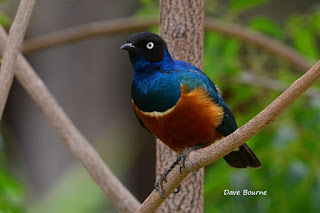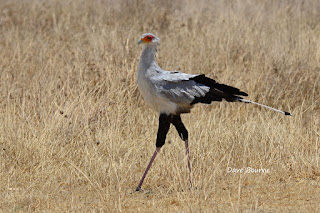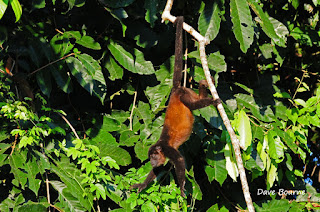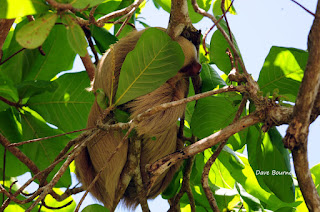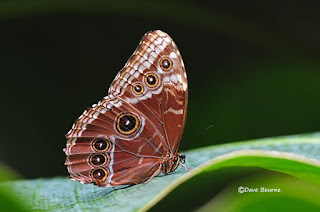The Vulturine Guineafowl is an unusually long-necked, long-tailed guineafowl with a mostly naked head.

Tuesday, November 30, 2021
Monday, November 29, 2021
Helmeted Guineafowl
The Helmeted Guineafowl is a large-bodied, small-headed, slaty-gray gamebird perfectly lined with rows of hundreds of white spots.
Sunday, November 28, 2021
Verreaux's Eagle Owl
Verreaux’s Eagle Owls are enormous, grayish owls with dark stripes framing the face. It has a pale, horn colored beak and large, dark eyes that are set off by weird and diagnostic fleshy-pink eyelids.
Occurs from arid savanna to mesic woodland to riverine forest; prefers areas with some tall trees for breeding and roosting. Hunts medium-sized mammals.
Saturday, November 27, 2021
Superb Starling
The Superb Starling is a chunky, short-tailed, colorful savanna starling. Note the white chest band, white undertail, and white patch on the underwing.
Found in a variety of dry or moderately moist habitats including savanna, woodland, thorn scrub, and villages, usually in small flocks, sometimes with other species of starlings.
Friday, November 26, 2021
White-brown Sparrow-weaver
The White-browed Sparrow-weaver is a predominantly brown, sparrow-sized bird found throughout central and north-central southern Africa.
Thursday, November 25, 2021
Grey-headed Sparrow
The Grey-headed Sparrow is a plain sparrow with a gray head and underparts, and brown back, wings, and tail.
Wednesday, November 24, 2021
Yellow-necked Spurfowl
The Yellow-necked Spurfowl is a species of bird in the family Phasianidae. It is found in Djibouti, Eritrea, Ethiopia, Kenya, Somalia, Sudan, Tanzania, and Uganda.
Tuesday, November 23, 2021
Red-billed Hornbill
The Red-billed Hornbill lives in open savanna, woodland and thorn scrub in sub-Saharan Africa. It is an omnivore, eating fruit, insects and small animals.
Monday, November 22, 2021
Secretary Bird
The Secretary Bird is a large, mostly terrestrial bird of prey. Endemic to Africa, it is usually found in the open grasslands and savanna of the sub-Saharan region.
The Secretary Bird hunts and catches prey, like snakes, on the ground, often stomping on victims to kill them.
Sunday, November 21, 2021
Lilac-breasted Roller
Today’s blog begins our trip through East Africa. We spent 19 days with just us and an absolutely terrific guide, Albert, camping at waterholes and riverbanks through Samburu National Preserve, the Laikipia Plateau, Lake Naivasha and Masai Mara National Reserve in the Great Rift Valley in Kenya. Then dropped down into Serengeti National Park and Ngorongoro Crater in Tanzania before returning to Ambroseli National Park in Kenya.
The Lilac-breasted Roller is a chunky, large-headed bird with a lilac breast, rusty cheeks, and spring-green crown.
Saturday, November 20, 2021
Common Pauraque
The Common Pauraque’s subtle brown, black, and gray plumage provides such excellent camouflage that it might as well be invisible in its daytime sleeping spots on open ground. If it wasn’t for our guide finding and pointing this bird out to us I’m sure we wouldn’t have found it.
From dusk till dawn, the male’s songs are anything but quiet, ranging from rising whistles to grunts that sound like frogs. It is skilled at catching flying insects and like all nightjars has a gaping wide mouth behind a tiny bill.
Friday, November 19, 2021
Spider Monkey
Spider monkeys live in the tropical rain forests of Central and South America and occur as far north as Mexico. We spent many mornings just sitting watching the Spider Monkeys swinging through the camp.
They have long, lanky arms and prehensile (gripping) tails that enable them to move gracefully from branch to branch and tree to tree.
Thursday, November 18, 2021
Dead Leaf Mantis
The Dead Leaf Mantis is a common name given to various species of Praying Mantis that mimic dead leaves.
Wednesday, November 17, 2021
White-nosed Coati
White-nosed coatis are small mammals native to North, Central and South America, from Arizona to Argentina. They have strong claws and long, highly mobile snouts well adapted for foraging in crevices and holes for food. Their thick, semi-prehensile tails are used for balance and often held erect above the body.
Coatis eat fruit, invertebrates, small rodents and lizards. They forage for food on the ground and occasionally in trees.
Coatis eat fruit, invertebrates, small rodents and lizards. They forage for food on the ground and occasionally in trees.
Tuesday, November 16, 2021
Hoffman's Two-toed Sloth
Hoffmann's two-toed sloths are heavily built animals with shaggy fur and slow, deliberate movements. They are named after the German naturalist Karl Hoffmann.
These sloths have only two toes on their fore feet, each ending with long, curved claws. Each of the hind feet has three clawed toes.
These sloths have only two toes on their fore feet, each ending with long, curved claws. Each of the hind feet has three clawed toes.
Monday, November 15, 2021
Collared Aracari
The Collared Aracari is a South American toucan that breeds from southern Mexico to Panama; as well as Ecuador, Colombia and Venezuela.
Sunday, November 14, 2021
Brown-throated Three-toed Sloth
The brown-throated three-toed sloth is a truly unique animal that inhabits the rainforest canopies of Central and South America. The term sloth is synonymous with the word slow, and sloths certainly live up to that definition.
Sloths evolved to expend very little energy because their diet does not provide them with a lot of calories and nutrition. Brown-throated sloths primarily eat tough, rubbery rainforest leaves.
Their stomachs are multi-chambered, similar to a cow’s stomach, and house a mix of bacteria which helps to slowly break down the leaves. It takes two weeks for a sloth to digest one meal — the slowest digestion time of any mammal!
Sloths are specially adapted to live among the treetops. Their fur hangs upside down, running from their stomachs to their backs. This is because sloths themselves usually hang upside down. The orientation of their fur helps the rain water flow away from their body.
In addition, sloths have large curved claws to help them effortlessly grasp branches and vines, and hang comfortably while they eat and sleep. Brown-throated three-toed sloths have three toes and three claws per foot.
Brown-throated sloths have the ability to rotate their heads like owls. They can turn their heads up to 300 degrees due to their unique neck structure. They have nine cervical vertebrae, as opposed to the seven that most mammals have. This allows for greater rotation, which helps the sloth scan for predators like spectacled owls, harpy eagles and snakes.
Saturday, November 13, 2021
Pale-billed Woodpecker
The Pale-billed Woodpecker is a large red-headed woodpecker of tropical forest in lowlands and foothills.
All plumages of the Pale-billed Woodpecker have a white V on the back.
Friday, November 12, 2021
White-faced Capuchin Monkey
The White-faced Capuchin monkey has black fur on their back and legs and white fur on their chest and face. The white-faced capuchins are known for the cap of black fur on their head.
Adult males can weigh up to eight pounds while females weigh about five pounds. These monkeys grow to be from 15 to 17 inches in length, not including its tail which is about the same length as its body.
Thursday, November 11, 2021
Masked Tree Frog
Masked Tree Frogs inhabit Humid Lowland Forests throughout the Pacific and Caribbean regions of Costa Rica.
Wednesday, November 10, 2021
Violaceous Trogon
These birds demonstrate a strange behavior that is commonly referred to as "anting." This involves carving into ant nests and allowing ants to release formic acid on their bodies.
Tuesday, November 9, 2021
Squirrel Monkey
Squirrel monkeys are New World monkeys. Squirrel monkeys live in the tropical forests of Central and South America in the canopy layer.
Squirrel monkeys can only sweat through the palms of their hands and feet and so must make use of other thermoregulation techniques such as behavioral changes and urine washing.
Monday, November 8, 2021
Lesser Anteater
Costa Rica has three species of anteater — lesser, giant and silky, the most common of which is the lesser anteater, otherwise known as the collared anteater.
Sunday, November 7, 2021
Baird's Tapir
Probably our best stop in Costa Rica was Corcovado National Park located on the west coast. To get to Corcovado we first flew to the coast, four wheeled it down the coast to a dock, took a fishing boat along the coast, then mule carted it up into the mountain area to the camp. Our guide/spotter while there was Jacob Sojo Mora and we can highly recommend him.
Although we seen a lot of wildlife while we were there, the Baird’s Tapir was definitely a highlight.
The Baird's Tapir may be active at all hours, but is primarily nocturnal. It forages for leaves and fallen fruit, using well-worn tapir paths which zig-zag through the thick undergrowth of the forest. The animal usually stays close to water and enjoys swimming and wading – on especially hot days, individuals will rest in a watering hole for hours with only their heads above water.
It generally leads a solitary life, though feeding groups are not uncommon, and individuals, especially those of different ages (young with their mothers, juveniles with adults) are often observed together. The animals communicate with one another through shrill whistles and squeaks. Wikipedia
Saturday, November 6, 2021
Boat-billed Heron
The Boat-billed Heron is a nocturnal heron of mangroves and freshwater marshes in tropical lowlands and spends the daytime roosting in trees, often in loose groups.
Friday, November 5, 2021
Howler Monkey
One of the truly memorable experiences of a visit to Costa Rica is being awaken every morning by the howls of the Howler Monkeys around the camp.
Thursday, November 4, 2021
Helmeted Iguana
The Helmeted Iguana is a medium sized lizard with long slim legs and very long toes. It can be grey, olive, brown, black or reddish-brown with irregular blotches.
Wednesday, November 3, 2021
Black River Turtle
The Black River Turtle, or Black Wood Turtle is a species of turtle in the family Geoemydidae. It is found in Costa Rica, Nicaragua and Panama.
Tuesday, November 2, 2021
Blue Morpho Butterfly
As its common name implies, the blue morpho butterfly’s wings are bright blue, edged with black. The blue morpho is among the largest butterflies in the world, with wings spanning from five to eight inches.
Their vivid, iridescent blue coloring is a result of the microscopic scales on the backs of their wings, which reflect light. The underside of the morpho’s wings, on the other hand, is a dull brown color with many eyespots, providing camouflage against predators such as birds and insects when its wings are closed.
Monday, November 1, 2021
Julia Butterfly
The Julia Butterfly is a species of brush-footed butterfly. It is native from Brazil to southern Texas and Florida, and in summer can sometimes be found as far north as eastern Nebraska.
Its wingspan ranges from 82 to 92 mm, and it is colored orange (brighter in male specimens) with black markings; this species is somewhat unpalatable to birds.
Subscribe to:
Posts (Atom)







